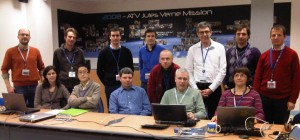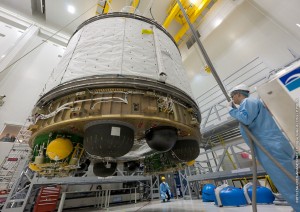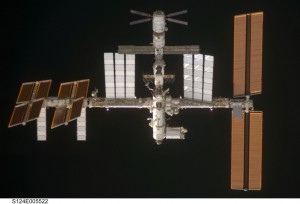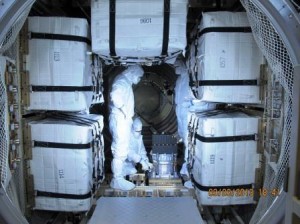Latest instalment of the mission diary from Charlotte Beskow, deputy ATV mission manager. Note the timeline of this post begins back in February and runs until last week – Ed.
ATV-4 launch: June 2013
i.e. we are still at roughly L – 3 months
ATV-5 launch: Early 2014
We are at less than L – 12 months!
14 March 2013 – On board AF 3508 over the Atlantic on my way to Kourou! Here comes a smattering of details and updates, showing you what daily life can be like in this most fascinating of all worlds!
ATV-4 is transporting cargo to the International Space Station!
- Fuel for the Russian engines – 860 kg
- (Russian) Water for the crew – 570 kg
- Air (66 kg) and Oxygen (33 kg) – 99 kg
- Fuel for maintaining ISS orbit/reboosts – 2,235 kg
- Dry Cargo – 2,506 kg
4 Feb 2013 – Simulation of of mission period launch to docking (LEDOWK)
This was an intensive week. It consisted of a full-scale simulation of launch to docking (LEDOWK, which normally takes ca. 8 days) at ATV-CC in Toulouse, involving the complete flight control team including the technical experts of the EST (Engineering Support Team) from ESTEC. To make it more interesting – and to make sure we are prepared for what might come during the real flight – the trainers worked overtime to put together various contingencies. These were selected based on previous flight experience, known weaknesses in the systems, and the sheer (evil? – Ed) inventiveness of the simulator experts.

Some of the Engineering Support Team (EST) members before the simulation started Credit: ESA/C. Beskow
As a consequence, LEDOWK is not the time to fine-tune your procedures, beef up you knowledge of ATV-CC nor develop working routines for the team. All this is either in place or will have to be dealt with some other time.
The EST are, by definition, called when problems arise. For us it was therefore a bit tricky to prepare a staffing plan that would not give away the planned failures. At the same time, we had to respect working-hour regulations and ‘normal manning for the flight’. This led to some bizarre shifts, in which people had to turn up more than once in a given 24-hour period. Some were also on call – no sooner had they dropped into bed than the phone would ring with a call from a colleague in need of some vital info.
In terms of failures, we were not disappointed. The sim team kept us on our toes 24h/24 from Monday afternoon until Friday lunch time. The flight control team next door run regular shifts, whereas our hours changed daily. Add to this the use of simulated ISS time (covering 12 March 08:00 to 17 March 23:00 – with a few gaps – and local time being 2 hours behind (which of course had no relation to the real Toulouse local time) and, in the end, we had little idea of what day or what time it really was.
This is exhausting!
An analysis of the time sheets show a normal working week i.e. ca 40 hours, but the many simulated failures, the erratic hours and the disturbed sleep meant that we felt as if we’d been working non-stop for two weeks.
Still, I must say, we all liked it. The failures are a challenge and it is fun to respond to them, to see if you can get the right information quickly enough, all the time knowing that if you fail, the worst thing that can happen is that the sim is stopped and restarted. Real life is different, hopefully very boring.
Remating Albert
Meanwhile, in Kourou, ATV Albert Einstein had been mated a second time just before LEDOWK started. Normally this is done only once during the pre-launch campaign, but the post-mating test had revealed a problem in the equipment connection, so the decision was taken to demate the spacecraft and the cargo carrier, remove the AAC (aft access closure) and fix the connector.

ATV Albert Einstein’s pressurised module suspended at Europe’s Spaceport, Kourou, French Guiana in preparation to integrate it with the rest of the spacecraft. The pressurised module is used to store cargo and, once docked with the International Space Station, becomes a temporary habitable module. Credit: ESA/CNES/Arianespace/Optique Video du CSG
This had all been done, ATV was put back together and – whilst we had been working on simulated failures – the team running the post-mating test had, on 6 Feb, detected a real one. A meeting convened on Thursday, 7 February, to discuss the situation: ‘Use as is’ or demate again and exchange the faulty equipment. Obviously, this was not an easy decision. The offending equipment belonged to a complex subsystem and exchanging it would mean extensive retesting and a launch delay.
On that Thursday, incidentally, we had the pleasure of following the launch of Ariane V 212 taking place in Kourou, from our PC screens, during the simulation!
Even though I work with space, I find it equally fantastic every time. Launching a rocket is never a ‘done deal’. It is a complicated system with numerous interfaces, and there are a multitude of things that can go wrong with a greater or lesser impact on the launch and subsequent operations. This makes every launch equally demanding, and explains why there can be a delay in readiness for launch at the last minute.

Old picture (June 2008) showing ATV-1 at the top (with the X-shaped solar arrays) and Columbus bottom right (white arrow). Note that the ISS has evolved since then! Credit: NASA
Thursday, 7 February was also five years to the day since a Shuttle launched carrying the European Columbus Laboratory, which was subsequently attached to the ISS. There was a celebration (!!!) in ESTEC; the rest if us spared it a thought but then got on with our work…
To cut a long story short, the teams in Kouoru, at ESTEC, and at Astrium (our ATV manufacturer) decided to replace the faulty equipment.
As a consequence, we would not be ready for launch by 18 April and this would move to May or even to June. Planning was again up in the air but… we had some breathing space.
9 February 2013 – Weekend in Toulouse.
What does a space engineer do in her spare time? I visited Cite de l’Espace! A neat space park just on the edge of Toulouse, complete with mock-up of the Russian ex-Space Station, MIR, movies from the Hubble Space telescope, Ariane engine parts and all kinds of interesting gadgets and hands-on displays. It is an ideal place to bring children and friends and also very educational, even when you work in this field.
11 February 2013 – My Toulouse stay continues.
Apart from a normal post-simulation review meeting and a Mission Management Meeting for ATV-4, we also had to prepare for the Joint Operations Readiness Review (JORR).
This is something imposed by the ‘certificate of flight readiness’ process and serves to ensure that a vehicle operator (us, in this case) are really ready for flight and subsequent operations. In short, you can say that the process ensures that all the ‘t’s are crossed and the ‘i’s dotted. This might sound needlessly bureaucratic, but one must bear in mind that most big failures are actually a series of small, manageable failures plus some unexpected circumstances.
The first such review we did for ATV-1, back in 2007, was a big affair that had us all working countless hours to tie up all loose ends. The ATV-3 one was, for my part, done at 04:00 in Kourou via telecon. We did an internal dry run on the 15th and there we had all the in-depth technical discussions, leaving enough time to finalise the necessary inputs for the ‘real’ review on the 21st.
The week also included discussions on whether or not to move the JORR review to a later date in view of the expected slip in readiness for launch – but we agreed that the logistics for rescheduling a multilateral review involving NASA and RSC Energia (our Russian partners) as well as several different ESA sites (Toulouse, Oberpfaffenhofen – they handle the communication links between ATV-CC and Moscow, Houston and White Sands – the Astrium site at Les Mureaux, etc.) outweighed the benefit. I was grateful for this because the logistics of trying to optimise working in several locations is very time consuming.
15 February also put space on the public map, in the shape of a meteorite (diameter 17 m!) that streaked across the sky of Siberia, leaving a wave of broken windows and perforated roofs in its wake. It also set off a brisk trade in meteorite pieces!
18 February 2013 – Monday-Wednesday; ATV-4 work is speeding ahead!
Bbut in parallel we have also begun preparations for ATV-5. Parts of the ATV production team are working full time on ATV-5, and the regular Mission Management meetings for ATV-5 have started. The meeting planned for this week was moved to March at the last minute, giving us more time to work through the issues encountered during the ATV-4 LEDOWK; we spent the days establishing priorities for the weeks to come and doing the final preparation for the Joint Operations Readiness Review on the 21st.
In Kourou the faulty ATV-4 equipment was exchanged inside the Integrated Cargo Carrier (ICC). Retesting could now get under way (to show that the system functions equally well with the new equipment). The team has requested night shifts and double Saturday shifts for the foreseeable future in order to make up for lost time.
21 February 2013 – JORR
As with most things that are well prepared, when it actually takes place everything runs so smoothly that it become almost a non-event. The review was declared a success and we now have a long list of open work actions to fulfil. On the other hand, we have more time now than we had 10 days ago. All we need now is a an update of the launch date.
25 February – 1 March 2013 – A normal week in the office!!!
Despite the email (or because of it?) you miss out on a lot of information when you are not in the office, so it was good to be back in ESTEC. A hot discussion topic this week, is, of course, the launch date. Two other launches have to be taken into consideration Vega and Soyuz.
All this is a ‘casse-tete’ for Arianespace and CSG (Centre Spatial Guyanais), who have to manage the launch site. The Kourou teams are multi-tasking and multi-launcher. Nevertheless, three types of launches in the same, short, time frame necessitate a certain amount of logistics in order to set up the proper configuration. Not all tasks can be done in parallel. Add to that that the month of May is peppered with holidays and you end up with a logistical spaghetti carbonara.
4 March 2013 – Kouoru: retesting is progressing fast
The remating of the ATV spacecraft to the ICC (Cargo Carrier) is scheduled for Friday, 15 March.
Late cargo starts arriving this week. Normally this is loaded during the final preparations, ca. 13 days before launch. One item, weighing 75 kg, is a water pump destined for the ESA lab, Columbus. With respect to this cargo item we are grateful for the delay and the (re)opening of the ATV rear entrance. It is a lot easier to handle a 75-kg item when you have a floor to stand on, rather than trying to strap it in, with ATV in vertical position on top of Ariane 5, whilst balancing on a very narrow platform.

Inside view taken 9 March; the water pump is installed, hard-mounted on a rack adapter plate Credit: ESA/C. Beskow
9 March 2013 – Early loading of ‘late-load cargo’ including the 75-kg water pump is completed.
That’s it for now!
I have left a cold and white Europe behind and am looking forward to the 25-29C in French Guyana, not to mention the exciting ‘ATV days’ ahead.
– Charlotte


 Automated Transfer Vehicle page
Automated Transfer Vehicle page ATV blog archive
ATV blog archive
Discussion: no comments